Variation of Subsoiling Effect at Wing Mounting Heights on Soil Properties and Crop Growth in Wheat–Maize Cropping System
Abstract
:1. Introduction
2. Materials and Methods
2.1. Experimental Site
2.2. Field Subsoiling Test Design
2.3. Variables Measurement and Analysis
2.3.1. Disturbance Area of Soil
2.3.2. Crop Growth Conditions
2.3.3. Crop Yield and Yield Components
2.4. Statistical Analysis
3. Results and Discussion
3.1. Characteristics of Disturbance Area of Soil
3.2. Soil Moisture Content
3.3. Soil Bulk Density
3.4. Emergence Rate and Crop Growth
3.5. Crop Yield and Some Yield Components
4. Conclusions
Author Contributions
Funding
Institutional Review Board Statement
Data Availability Statement
Acknowledgments
Conflicts of Interest
References
- He, J.; Li, H.W.; Chen, H.T.; Lu, C.Y.; Wang, Q.J. Research progress of conservation tillage technology and machine. Trans. CSAM 2018, 49, 1–19. [Google Scholar] [CrossRef]
- Song, W.; Jiang, X.H.; Li, L.K.; Ren, L.L.; Tong, J. Increasing the width of disturbance of plough pan with bionic inspired subsoilers. Soil Till. Res. 2022, 220, 105356. [Google Scholar] [CrossRef]
- Xue, S.P.; Zhu, R.X.; Yan, X.L.; Sun, L.; Han, S.M.; Zhang, Z.H.; Wu, J.P.; Hou, Z.F.; Wang, Z.Y.; Huang, Y.M.; et al. Conservation Tillage Technology; Shaanxi Science and Technology Press: Xi’an, China, 2011. [Google Scholar]
- Mohammad, A.; Yousef, A.G. Assessment of adaptive neuro-fuzzy inference system and response surface methodology approaches in draft force prediction of subsoiling tines. Soil Till. Res. 2019, 194, 104338. [Google Scholar] [CrossRef]
- Wang, Y.; Zhang, D.; Yang, L.; Cui, T.; Jing, H.; Zhong, X. Modeling the interaction of soil and a vibrating subsoiler using the discrete element method. Comput. Electron. Agric. 2020, 174, 1–14. [Google Scholar] [CrossRef]
- Zhang, Q.; Wang, S.; Zhang, Y.; Li, H.; Liu, P.; Wang, R.; Wang, X.; Li, J. Effects of subsoiling rotational patterns with residue return systems on soil properties, water use and maize yield on the semiarid Loess Plateau. Soil Till. Res. 2021, 214, 105186. [Google Scholar] [CrossRef]
- Zhang, X.R.; Wang, C.; Chen, Z.S.; Zeng, Z.W. Design and experiment of a bionic vibratory subsoiler for banana fields in southern China. Int. J. Agric. Biol. Eng. 2016, 9, 75–83. [Google Scholar] [CrossRef]
- Wang, Y.; Li, N.; Ma, Y.; Tong, J.; Pfleging, W.; Sun, J. Field experiments evaluating a biomimetic shark-inspired (BioS) subsoiler for tillage resistance reduction. Soil Till. Res. 2020, 196, 104432. [Google Scholar] [CrossRef]
- Wang, X.Z.; Li, P.; He, J.P.; Wei, W.Q.; Huang, Y.X. Discrete element simulations and experiments of soil-winged subsoiler interaction. Int. J. Agric. Biol. Eng. 2021, 14, 50–62. [Google Scholar] [CrossRef]
- Godwin, R.J.; Spoor, G.; Leeds-Harrison, P. An experimental investigation into the force mechanics and resulting soil disturbance of mole ploughs. J Agric. Eng. Res. 1981, 26, 477–497. [Google Scholar] [CrossRef]
- Hang, C.G.; Huang, Y.X.; Gao, X.; Li, W.; Zhu, R. Experiment and analysis of the subsoiler tine shape to the soil disturbance process and effect. Agric. Res. Arid Areas 2017, 35, 285–291. [Google Scholar] [CrossRef]
- Wei, Z.J.; Zheng, D.K.; Yang, D.T.; Sun, F.Y. Kinetic characteristic analysis and experimental study for subsoiler with wing. Agric. Mecha. Res. 2017, 12, 32–37. [Google Scholar]
- Zen, W.B.; Yang, D.T.; Huang, S.X. Experimental research of winged subsoiler. Agric. Mecha. Res. 2011, 8, 130–138. [Google Scholar]
- Gao, H.W.; Li, H.W. A testing study of dryland subsoiling. Agric. Res. Arid Areas 1995, 13, 126–133. [Google Scholar]
- Xia, L. Optimum parameter and experimental study of shovel wing based on discrete element method. Master’s Thesis, Northwest A&F University, Xianyang, China, 2018. [Google Scholar]
- Li, H.W.; Chen, J.D.; Li, W.Y. Study on subsoiling technique for conservation tillage field. Trans. CSAM 2000, 31, 42–45. [Google Scholar]
- Huang, Y.; Hang, C.; Yuan, M.; Wang, B.; Zhu, R. Discrete element simulation and experiment on disturbance behavior of subsoiling. Trans. CSAM 2016, 47, 80–88. [Google Scholar] [CrossRef]
- Zhao, S.; Wang, J.; Chen, J.; Yang, Y.; Tan, H. Design and experiment of fitting curve subsoiler of conservation tillage. Trans. CSAM 2018, 49, 82–92. [Google Scholar] [CrossRef]
- Zeng, Z.W.; Chen, Y.; Zhang, X. Modelling the interaction of a deep tillage tool with heterogeneous soil. Comput. Electron. Agric. 2017, 143, 130–138. [Google Scholar] [CrossRef]
- Wang, Q.J.; Wang, X.L.; Li, H.W.; He, J.; Zhang, Y.F.; Huang, X.Y. Effect of maize straw mulching on winter wheat growth in double Cropping Area of Northern China. Trans. CSAM 2017, 48, 192–198. [Google Scholar] [CrossRef]
- Zhao, H.B.; He, J.; Li, H.W.; Wang, Q.J.; Li, W.Y.; Liu, W.Z. Effect of straw returning manners on seedbed soil physical properties and winter wheat growth. Trans. CSAM 2018, 49, 60–67. [Google Scholar] [CrossRef]
- He, M.; Gao, H.W.; Dong, P.Y.; Cui, D.J.; Zhao, W.G. Sub-soiling Experiment on Double Cropping and Conservation Tillage Adopted Area. Trans. CSAM 2018, 49, 58–63. [Google Scholar] [CrossRef]
- Chen, Y.; Cavers, C.; Tessier, S.; Monero, F.; Lobb, D. Short-term tillage effects on soil cone index and plant development in a poorly drained, heavy clay soil. Soil Till. Res. 2005, 82, 161–171. [Google Scholar] [CrossRef]
- Letey, J. Relationship between soil physical properties and crop production. Adv. Soil Sci. 1995, 1, 277–294. [Google Scholar] [CrossRef]
- Li, J.; Huang, P.T.; Wang, Z.H. Key Technology of Wheat and Corn Double Cropping; China Agricultural Science and Technology Press: Beijing, China, 2012. [Google Scholar]
- Zhu, X.M. Soil and Agriculture on the Loess Plateau; Agriculture Press: Beijing, China, 1989. [Google Scholar]
- Hamza, M.A.; Anderson, W.K. Combinations of ripping depth and tine spacing for compacted sandy and clayey soils. Soil Till. Res. 2008, 99, 213–220. [Google Scholar] [CrossRef]
- Yao, Y.X. Numerical simulation and experimental study on soil Infiltration of subsoiling. Master’s Thesis, Northwest A&F University, Xianyang, China, 2019. [Google Scholar]
- Zhao, M.; Zhang, J.C.; Xu, Y.S.; Zhang, Y.C.; Zhang, Q.G. Analysis of effect to terrafit fertilizer on growth and yield of crops in sandy area. Acta Agric. Boreali Occident. Sin. 2006, 15, 100–103. [Google Scholar]
- Ge, S. Effects of Subsoiling on Paddy Soil Physical Properties and Growth of Wheat. Master’s Thesis, Nanjing Agricultural University, Nanjing, China, 2017. [Google Scholar]
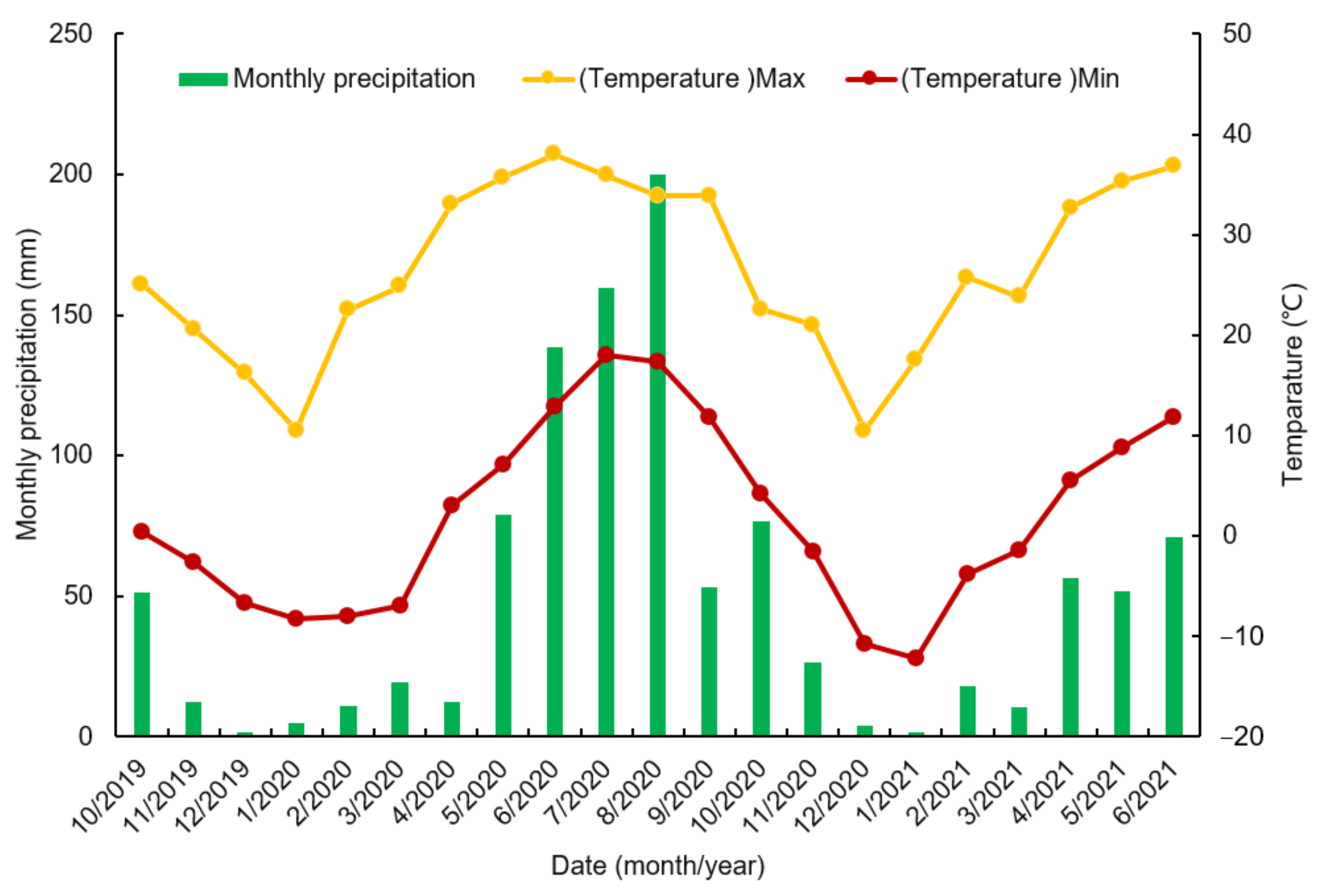



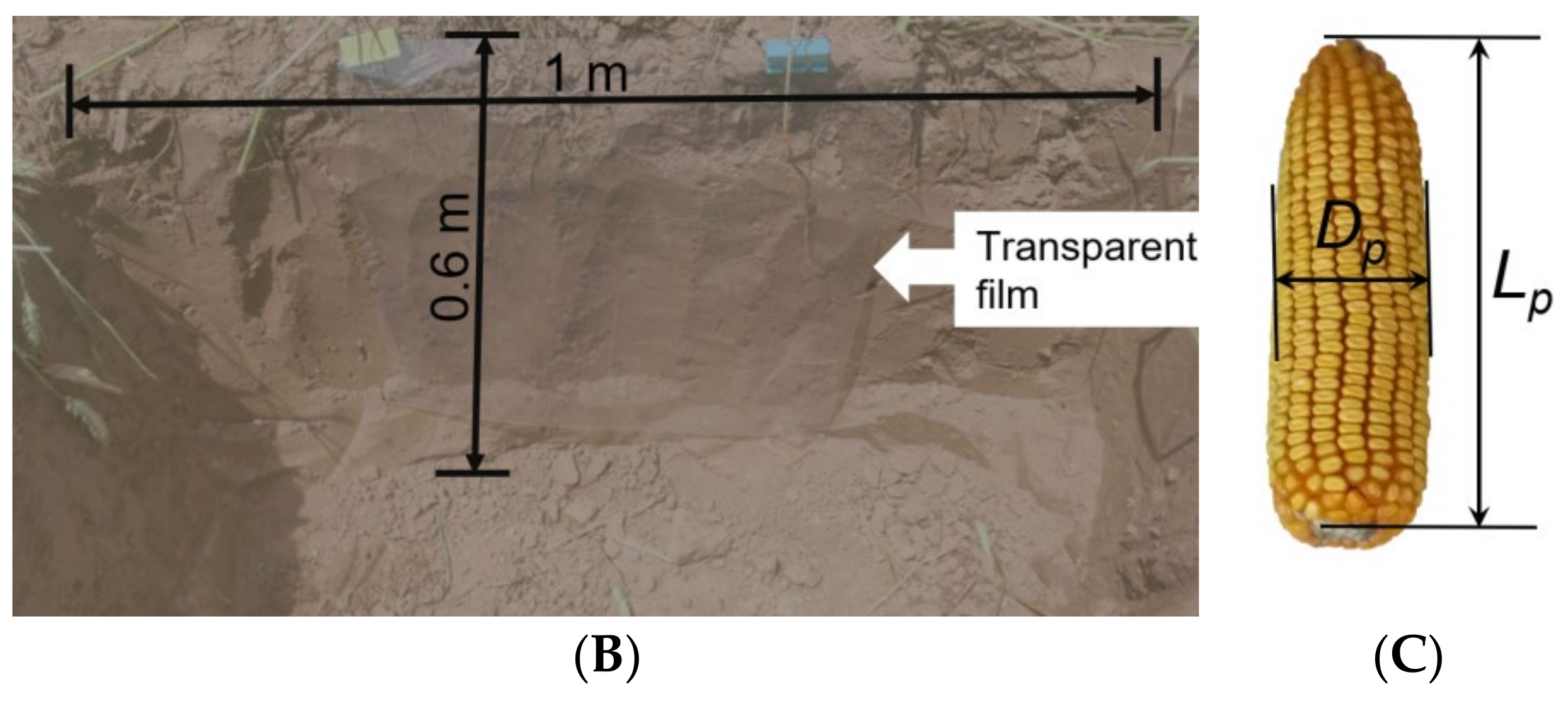
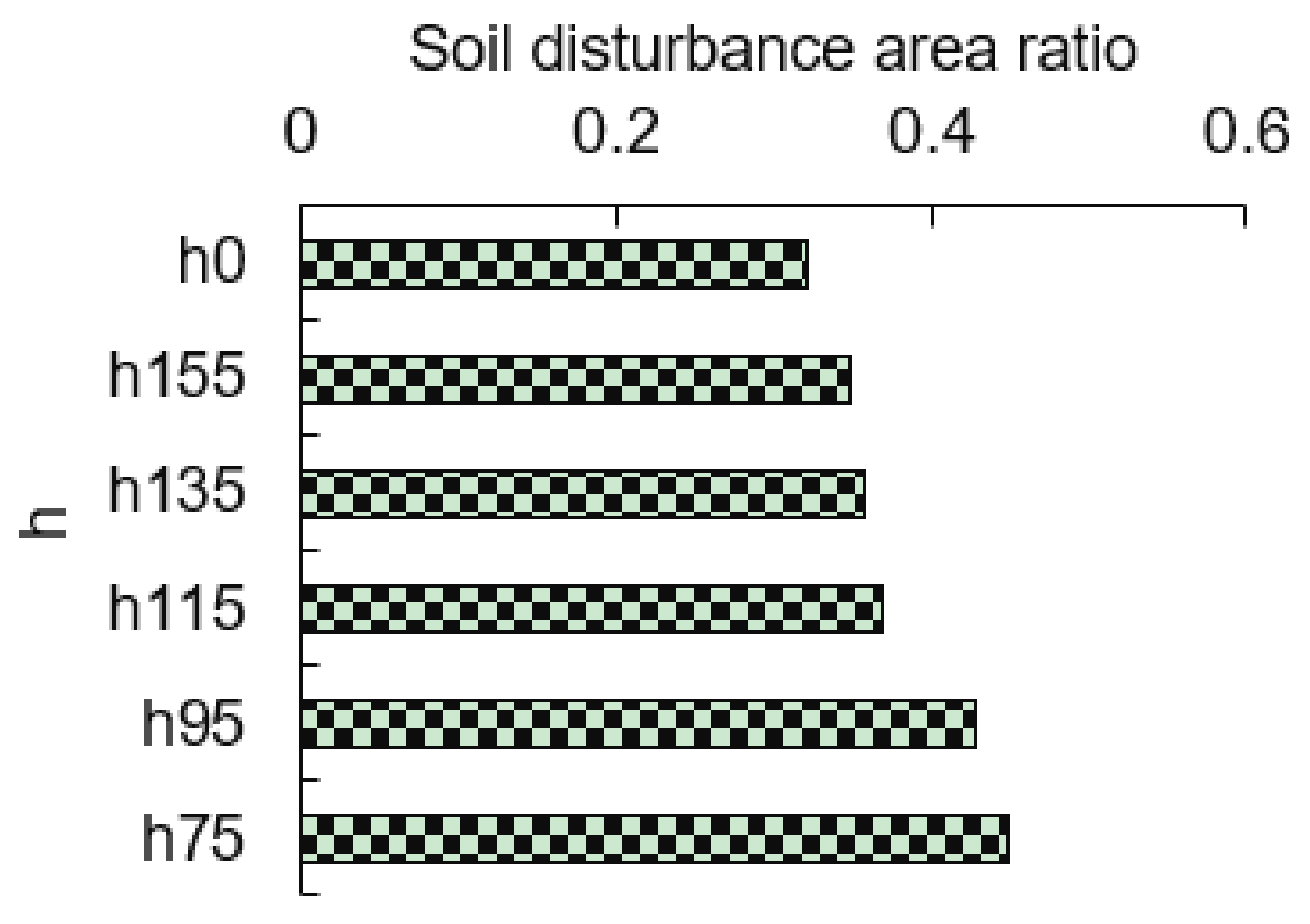
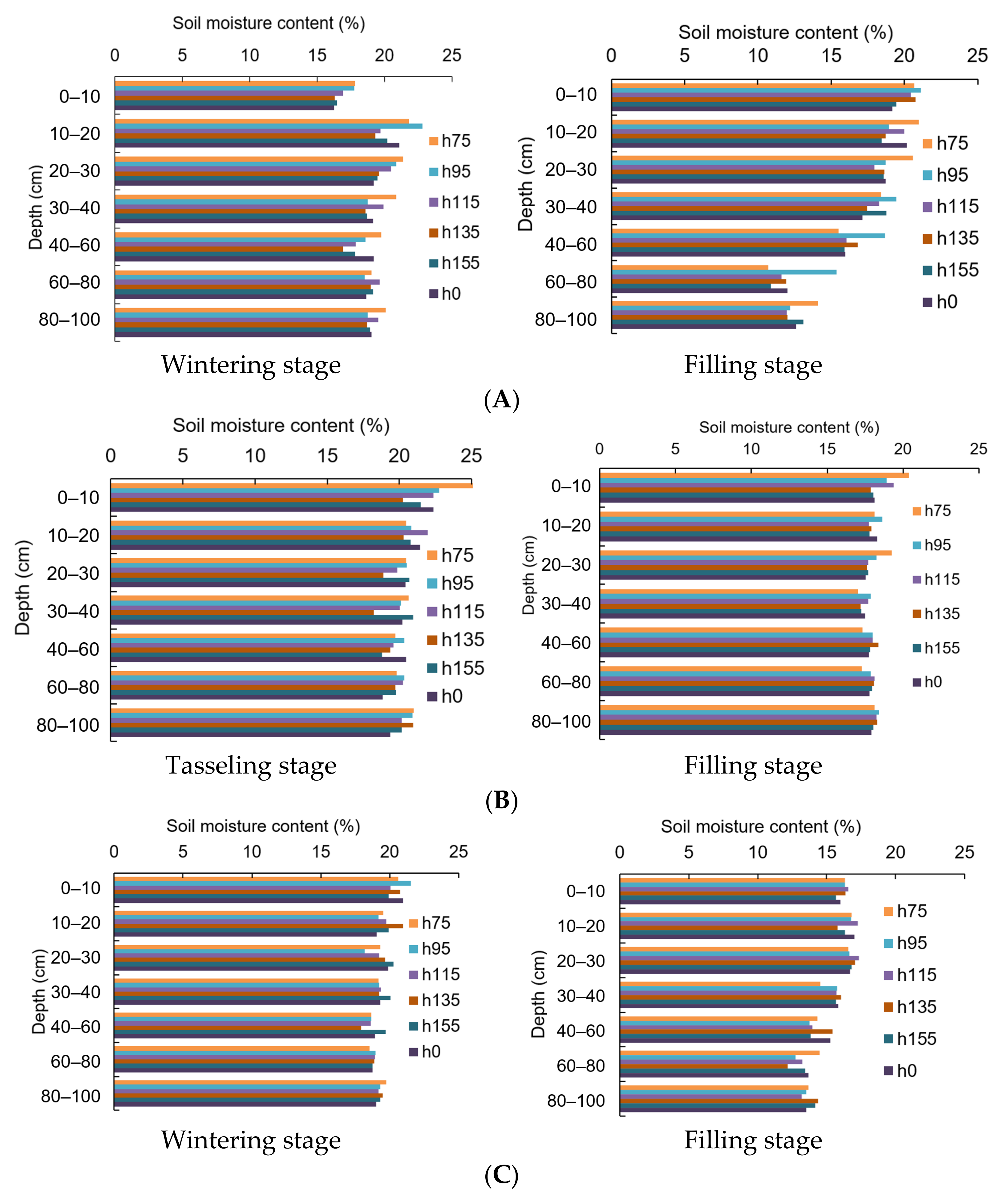

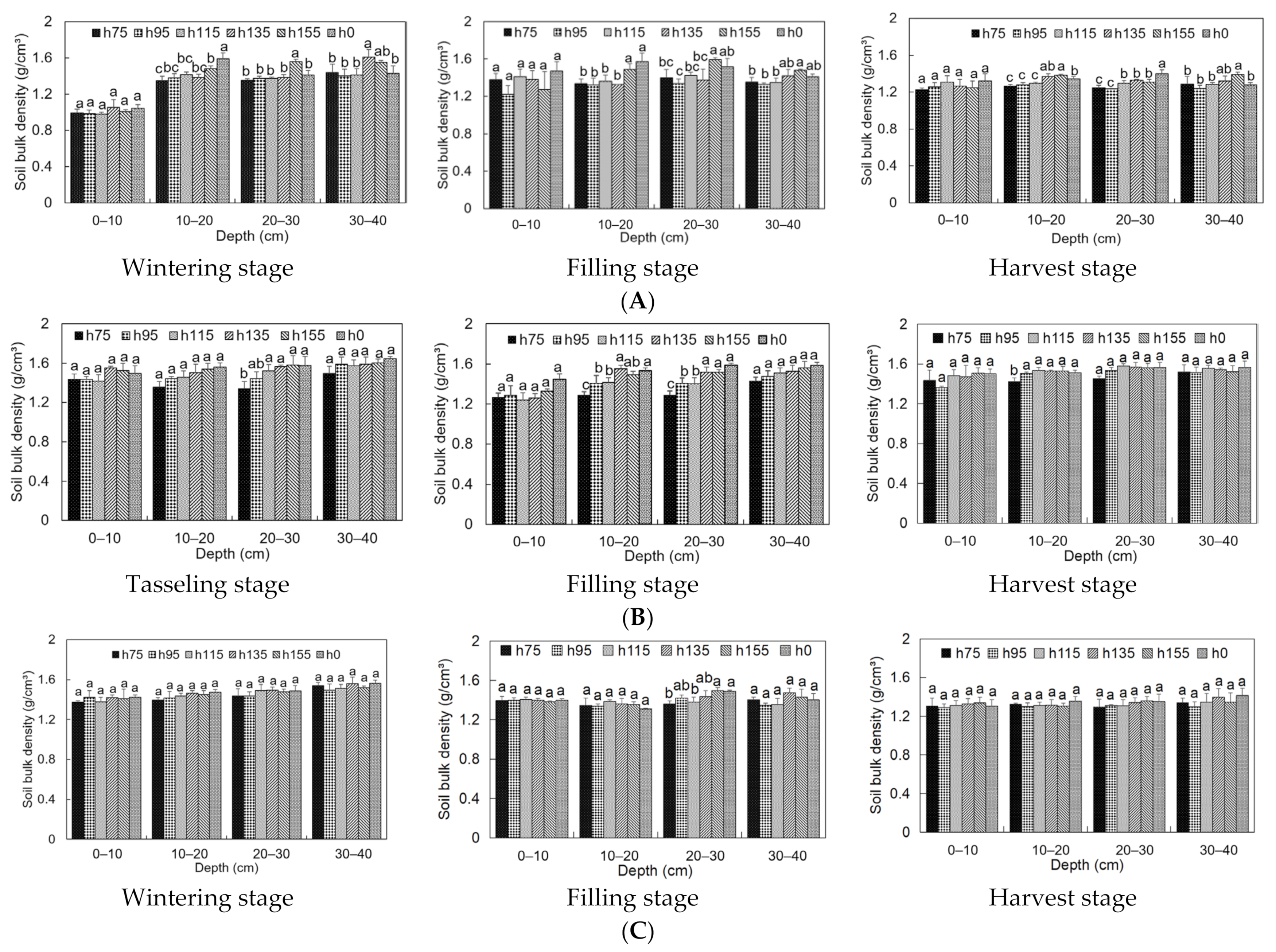
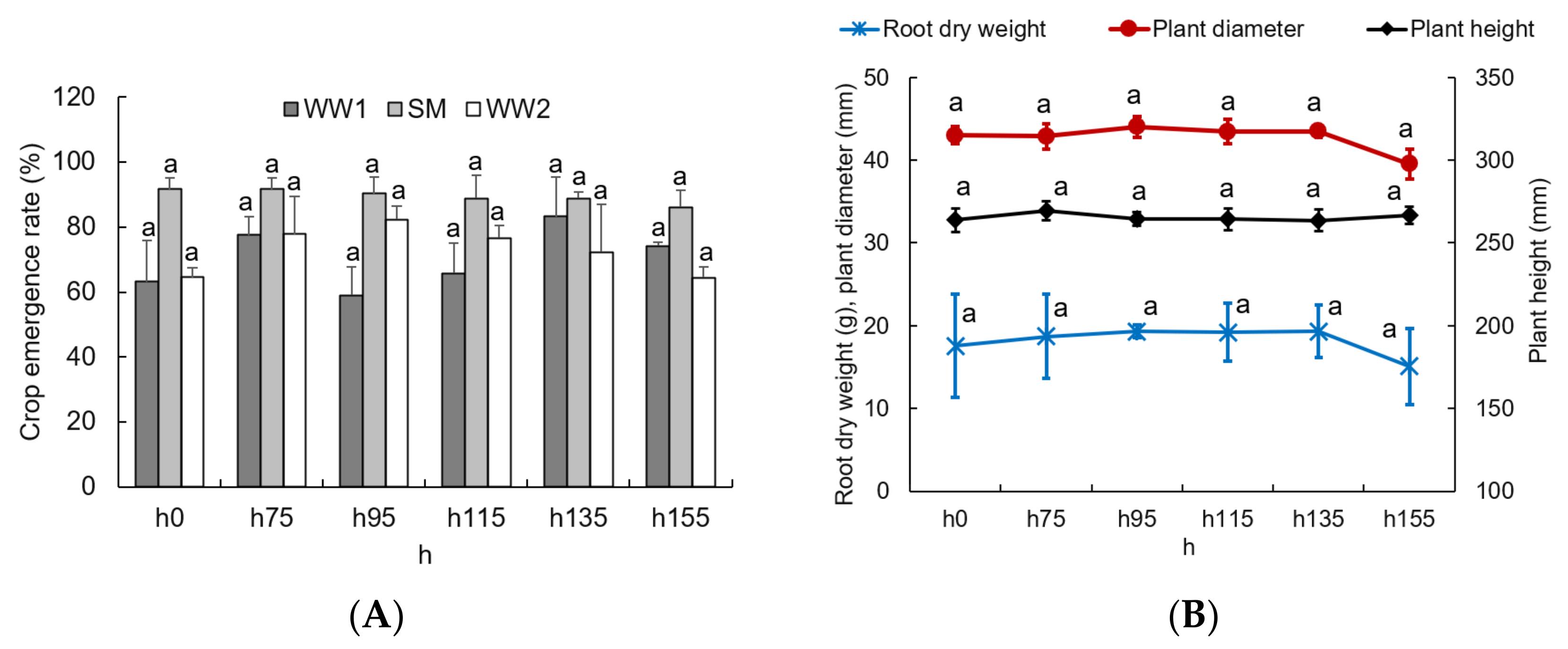
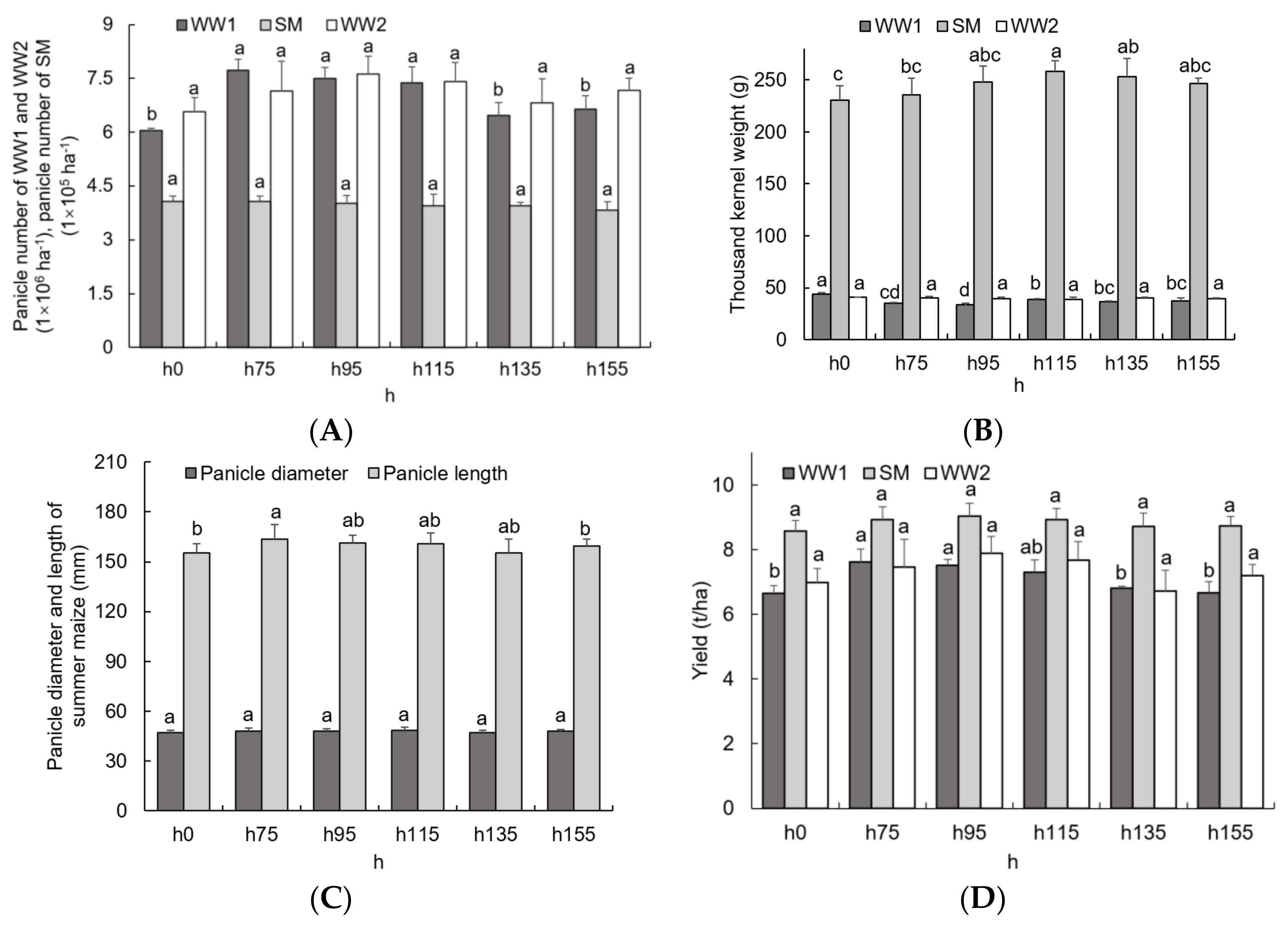
| Soil Depth (cm) | h0 | h75 | h95 | h115 | h135 | h155 | |
|---|---|---|---|---|---|---|---|
| 0–8 | WW1 | 40.7 a | 66.3 a | 47.0 a | 53.7 a | 54.3 a | 50.3 a |
| WW2 | 35.3 a | 36.3 a | 42.0 a | 41.0 a | 43.3 a | 45.3 a | |
| 8–16 | WW1 | 56.7 a | 93.7 a | 95.0 a | 84.3 a | 89.3 a | 55.7 a |
| WW2 | 36.3 a | 45.7 a | 53.7 a | 49.0 a | 37.7 a | 32.7 a | |
| 16–24 | WW1 | 24.7 b | 50.0 a | 55.7 a | 49.7 a | 59.0 a | 32.7 b |
| WW2 | 19.0 a | 30.3 a | 22.3 a | 23.3 a | 29.3 a | 19.0 a | |
| 24–32 | WW1 | 15.7 ab | 24.3 a | 27.0 a | 16.7 ab | 18.3 a | 6.00 b |
| WW2 | 13.7 a | 16.7 a | 19.3 a | 13.7 a | 12.7 a | 12.3 a | |
| 32–40 | WW1 | 2.3 b | 20.7 a | 20.0 a | 10.7 ab | 9.3 ab | 6.7 b |
| WW2 | 6.3 a | 4.7 a | 6.3 a | 6.7 a | 4.3 a | 5.3 a | |
Publisher’s Note: MDPI stays neutral with regard to jurisdictional claims in published maps and institutional affiliations. |
© 2022 by the authors. Licensee MDPI, Basel, Switzerland. This article is an open access article distributed under the terms and conditions of the Creative Commons Attribution (CC BY) license (https://creativecommons.org/licenses/by/4.0/).
Share and Cite
Wang, X.; Zhou, H.; Huang, Y.; Ji, J. Variation of Subsoiling Effect at Wing Mounting Heights on Soil Properties and Crop Growth in Wheat–Maize Cropping System. Agriculture 2022, 12, 1684. https://doi.org/10.3390/agriculture12101684
Wang X, Zhou H, Huang Y, Ji J. Variation of Subsoiling Effect at Wing Mounting Heights on Soil Properties and Crop Growth in Wheat–Maize Cropping System. Agriculture. 2022; 12(10):1684. https://doi.org/10.3390/agriculture12101684
Chicago/Turabian StyleWang, Xuezhen, Hao Zhou, Yuxiang Huang, and Jiangtao Ji. 2022. "Variation of Subsoiling Effect at Wing Mounting Heights on Soil Properties and Crop Growth in Wheat–Maize Cropping System" Agriculture 12, no. 10: 1684. https://doi.org/10.3390/agriculture12101684





